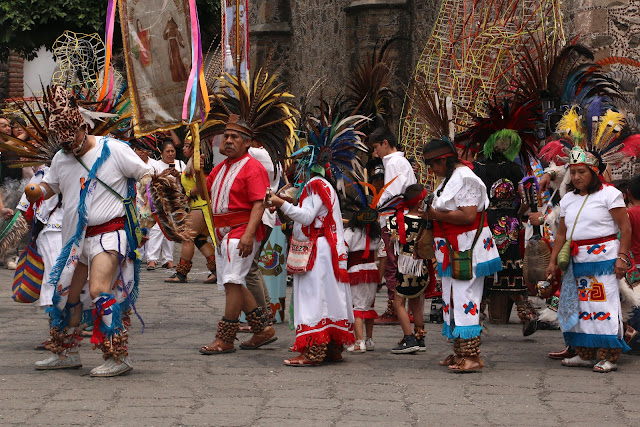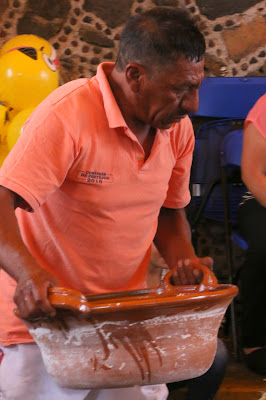One day in the autumn of 2018, via Facebook, we received a message inviting us to visit an original pueblo we had not previously heard of, Peñon de los Baños, Rocky Mount of the Baths. The invitation came from a group that seeks to maintain and promote the history and traditions of el Peñon, Tlaloc Tezcatlipoca (the names of the Aztec gods of water and of the night). We gladly accepted and arranged to visit on the Day of the Dead, Nov. 1-2.
We did not know its location or why baths were associated with it. Checking our maps of the delegacions/alcaldías of the city, we located it in Delegación Venustiano Carranza, east of Centro, the former Tenochtitlan. To our amazement, it was right next door to Terminal One of the Mexico City International Airport, which we have passed through numerous times! What a combination, but a typical Mexico City contrast of epochs standing side by side: an original pueblo next to a major modern airport.
Researching further (in Wikipedia en español), we learned that el Peñon was a mount of solid volcanic rock that originally protruded from the middle of Lake Texcoco, some distance east of Tenochtitlan and the numerous islands of the southwest bay of the lake. In indigenous times it was known as Tepetzinco.
Besides being a lone rocky mount in the middle of a lake, el Peñon had another unique feature. Hot mineral waters flowed from the base of the hill. In indigenous times, the Mexica royalty bathed in their medicinal waters. After the Conquest, in 1539, Peñon of the Baños was given by Cortés as an encomienda, grant, to the conquistador Diego de Ordaz, with its people serving him as peones, serfs.
Two hundred years later, in 1759, Carlos de José Dueñas Pacheco became the new owner of the island, acquiring it for the sum of $2,025 pesos from the Ordaz family. He rebuilt the baths. He also built a chapel "that would allow patients to come on Saturday afternoon, bathe at dusk and sleep there in order to hear Mass on Sunday morning."
Instead, in 1782, all the residents were moved to barrios in Mexico City. The rocky mount began to be quarried for its tezontle, volcanic rock, used in construction. Into the 19th century, the former residents protested to be allowed to return to el Peñon and form a recognized pueblo.
We did not know its location or why baths were associated with it. Checking our maps of the delegacions/alcaldías of the city, we located it in Delegación Venustiano Carranza, east of Centro, the former Tenochtitlan. To our amazement, it was right next door to Terminal One of the Mexico City International Airport, which we have passed through numerous times! What a combination, but a typical Mexico City contrast of epochs standing side by side: an original pueblo next to a major modern airport.
Researching further (in Wikipedia en español), we learned that el Peñon was a mount of solid volcanic rock that originally protruded from the middle of Lake Texcoco, some distance east of Tenochtitlan and the numerous islands of the southwest bay of the lake. In indigenous times it was known as Tepetzinco.
History of el Peñon de los Baños
Besides being a lone rocky mount in the middle of a lake, el Peñon had another unique feature. Hot mineral waters flowed from the base of the hill. In indigenous times, the Mexica royalty bathed in their medicinal waters. After the Conquest, in 1539, Peñon of the Baños was given by Cortés as an encomienda, grant, to the conquistador Diego de Ordaz, with its people serving him as peones, serfs.
Two hundred years later, in 1759, Carlos de José Dueñas Pacheco became the new owner of the island, acquiring it for the sum of $2,025 pesos from the Ordaz family. He rebuilt the baths. He also built a chapel "that would allow patients to come on Saturday afternoon, bathe at dusk and sleep there in order to hear Mass on Sunday morning."
 |
| Chapel of Our Lady of the Baths from the Facebook page: Tlaloc Tezcatlipoca |
The indigenous residents filed a formal complaint with the viceroy against Pacheco demanding the free use of open land for pasture for their livestock, but it was denied.
Instead, in 1782, all the residents were moved to barrios in Mexico City. The rocky mount began to be quarried for its tezontle, volcanic rock, used in construction. Into the 19th century, the former residents protested to be allowed to return to el Peñon and form a recognized pueblo.
 |
| Lake Texcoco (here spelled Tezcuco) in the mid-19th century. Peñon de los Baños is the hill near the southwestern corner of the lake, almost directly east of the City of Mexico (former Tenochtitlan). (Note that to the south, the Iztapalapa Peninsula has disappeared, having become merged with the original mainland, as has the former island pueblo of Iztacalco.) |
With the slow drying of Lake Texcoco by the Spanish, to prevent flooding of Mexico City in the rainy season, by the 19th century, el Peñon was no longer an island, but a hill at the marshy edges of what remained of the lake.
In the 19th and early 20th century, the baths were turned into an elegant spa, with restaurants, musical shows and hotel rooms.
In the 1930s, some years after the Mexican Revolution (1910-17), which, in part was fought for the return of lands to the indigenous peoples, President Lázaro Cárdenas granted now-dried lake bed as ejido, communal land, to the descendants of the original residents of el Peñon. They used it to grow alfalfa to feed livestock, while still fishing in the waters of the remaining lake.
However, the communal use of pastureland on the former lake bed did not last long. In 1950, the federal government expropriated the land to expand the Mexico City Airport by adding longer runways for international flights and a large terminal to a small airport that had existed since the 1920s. The community still awaits the promised compensation for their expropriated land.
Given its nearly 150-year-long hiatus as a pueblo, the current residents of el Peñon work hard to promote and maintain its identity as such. It holds a number of fiestas, including Tres Reyes (Three Kings Day, January 6) at one of the pueblo's three churches which is dedicated to the kings.


The pueblo also holds a big celebration of Cinco del Mayo, the Fifth of May, the anniversary of the Mexican Army´s defeat of the French Army in 1862 in the Battle of Puebla. The French, on the orders of Emperor Napoleon III and with the support of Mexican conservatives, invaded the country to remove the Reform government of Benito Juárez and replace it with that of Emperor Maximilian I, a younger brother of the Hapsburg Emperor of the Austrian Empire. This is an occasion grandly celebrated in the City of Puebla, but not much otherwise in Mexico. The celebration in el Peñon is an exception. We attended in 2019 and it turned out to be a large and delightful extravaganza. So, we will present it in a second post on the unique el Peñon de los Baños.
In the 19th and early 20th century, the baths were turned into an elegant spa, with restaurants, musical shows and hotel rooms.
 |
| Baths in the early 20th century From: Guia de la Ciudad de México por Travesia (Tour guide to Mexico City) |
In the 1930s, some years after the Mexican Revolution (1910-17), which, in part was fought for the return of lands to the indigenous peoples, President Lázaro Cárdenas granted now-dried lake bed as ejido, communal land, to the descendants of the original residents of el Peñon. They used it to grow alfalfa to feed livestock, while still fishing in the waters of the remaining lake.
 |
| Peñon de los Baños Aerial photo, early 20th century, looking southeast. Note the extensive marshlands around the waters of what still remained of Lake Texcoco in the distance. The Sierra de Catarina is just across the lake. In the distance are the volcanoes, Iztaccihuatl and Popocatepetl. from the Facebook page: Tlaloc Tezcatlipoca |
However, the communal use of pastureland on the former lake bed did not last long. In 1950, the federal government expropriated the land to expand the Mexico City Airport by adding longer runways for international flights and a large terminal to a small airport that had existed since the 1920s. The community still awaits the promised compensation for their expropriated land.
 |
| Original airport with two runways from the Facebook page: Tlaloc Tezcatlipoca |
 |
| Mexico City International Airport runways today, seen from Peñon de los Baños from the Facebook page: Tlaloc Tezcatlipoca |
Today, el Peñon de los Baños is another urban neighborhood immersed in the city. The rocky Peñon, of course, is still there, but topped by a military installation and a radio tower for the airport.
El Peñon today
from the Facebook page: Tlaloc Tezcatlipoca
Amazingly, we learned that, through all these dramatic changes, the baths still exist and are open to the public, now housed unpretentiously on the ground floor of an apartment complex. We haven't able to experience them yet, but hope to someday.
 |
| Baths Today From: Guia de la Ciudad de México por Travesia (Tour guide to Mexico City) |
Maintaining Traditions
Given its nearly 150-year-long hiatus as a pueblo, the current residents of el Peñon work hard to promote and maintain its identity as such. It holds a number of fiestas, including Tres Reyes (Three Kings Day, January 6) at one of the pueblo's three churches which is dedicated to the kings.
 |
| Surprisingly, the fiesta includes a calbagata, a horseback ride. We learn from one of the riders that all these horses are housed right here in Peñon de los Baños! |
 |
| A vaquero, cowboy, does rope tricks. |
 |
| A horse dances to the music of a banda. |

 |
| Charros, fancy Spanish caballeros, gentlemen and ladies horseriders, dance. |

It holds a carnaval before Easter (we weren't able to attend) and, on Day of the Dead, Nov. 1-2, it honors its dead in its panteón (cemetery), which it recently got renovated and officially named Panteon del Peñon de los Banos. Actually, it is located across the boundary street of the pueblo, in Colonia Pensador Mexicano (Mexican Thinker), which was originally part of the pueblo.
 |
| Recently restored panteón, pueblo's cemetery. from the Facebook page: Tlaloc Tezcatlipoca |
More Fiestas to Come
The pueblo also holds a big celebration of Cinco del Mayo, the Fifth of May, the anniversary of the Mexican Army´s defeat of the French Army in 1862 in the Battle of Puebla. The French, on the orders of Emperor Napoleon III and with the support of Mexican conservatives, invaded the country to remove the Reform government of Benito Juárez and replace it with that of Emperor Maximilian I, a younger brother of the Hapsburg Emperor of the Austrian Empire. This is an occasion grandly celebrated in the City of Puebla, but not much otherwise in Mexico. The celebration in el Peñon is an exception. We attended in 2019 and it turned out to be a large and delightful extravaganza. So, we will present it in a second post on the unique el Peñon de los Baños.
 |
| Delegación/Alcaldá Venustiano Carranza is the chartreuse area in the northeast of Mexico City |








































































